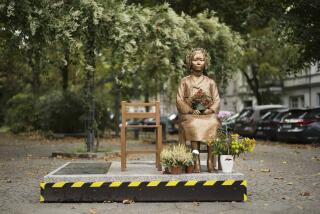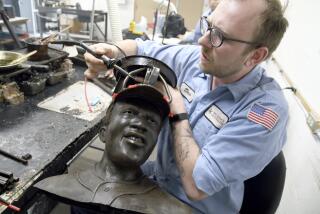Commentary: Confederate monuments institutionalize racism. Take them all down. Now
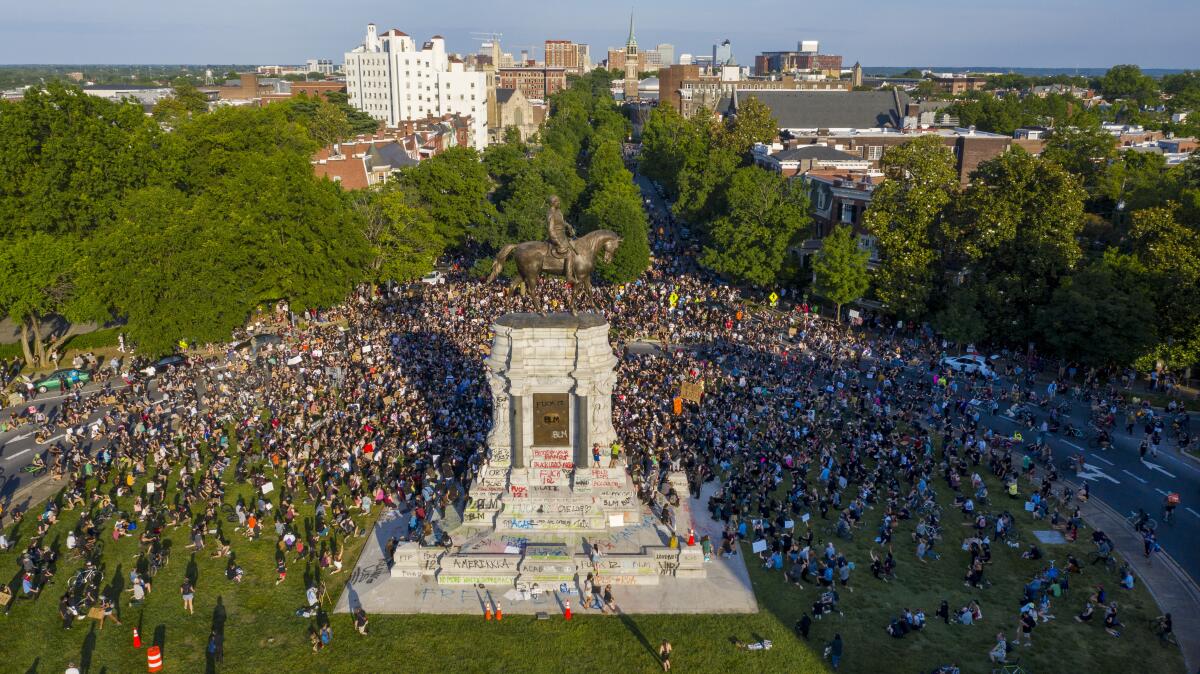
- Share via
A racist civic sculpture celebrating white supremacy was taken down off its pedestal on Tuesday in Alexandria, Va. The action, dramatic and long overdue, represents a sliver of light piercing the current gloom.
The bronze figure of a lone Confederate soldier, positioned to face due south, had stood for 131 years in the city’s historic core, just seven short miles from the White House and eight from the U.S. Capitol dome. Beneath the now-banished statue, an inscription on the base declares: “They died in the consciousness of duty faithfully performed.”
Consciousness. Duty. Faith. This civic salute to a gross perversion of human decency could hardly be more unashamed.
Memorial sculptures like this one have a specific purpose. They cast institutional racism in bronze.
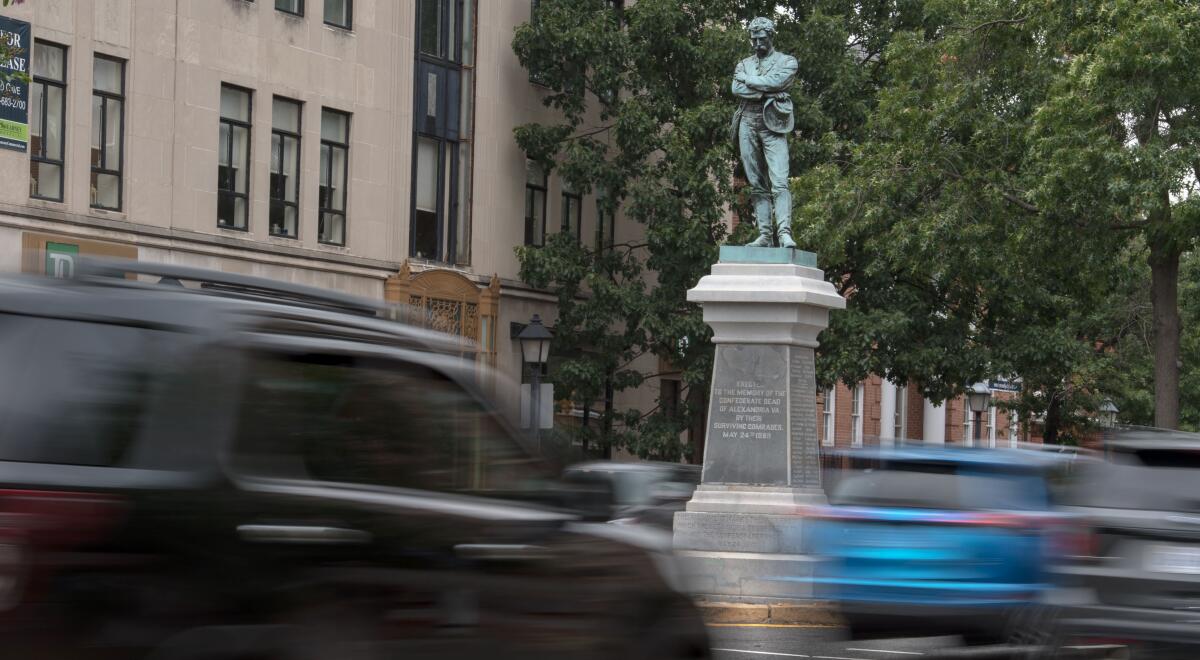
Alexandria’s effigy of a Confederate warrior was erected in 1889 to tell white Virginians that they might have lost the Civil War, but they still held the reins of power.
And it told black Virginians — in no uncertain terms — to know their place.
Intimidation was one objective of every such sculpture or plaque, the assertion of white privilege another. Postwar Reconstruction, a tumultuous experiment in interracial democracy, had by then been effectively crushed. Civil rights continued to crumble under white rule. The production of hundreds of Confederate monuments gave visual form to Jim Crow’s rise.
Those functions are not unrelated to the police killing of George Floyd, an unarmed African American, in Minneapolis last week. The catalytic event in Minnesota triggered a wave of unrest across hundreds of cities, large and small, that has yet to subside. To police civil society, silently but inescapably, is such a sculpture’s job.
A statue like Alexandria’s marshals a symbolic eternity, signaled by enduring bronze. It is lifted onto an immovable soapbox, chiseled from stone or cast in concrete. It commands a public space, pressing a metaphorical knee into the back of any citizen who might dare to object.
Hundreds of those sculptural knees remain in place today on streets, in parks and even on college campuses across the United States. The Southern Poverty Law Center estimated last year that more than 1,700 Confederate monuments still stand.
Will Floyd’s legacy include their belated removal? We can hope.
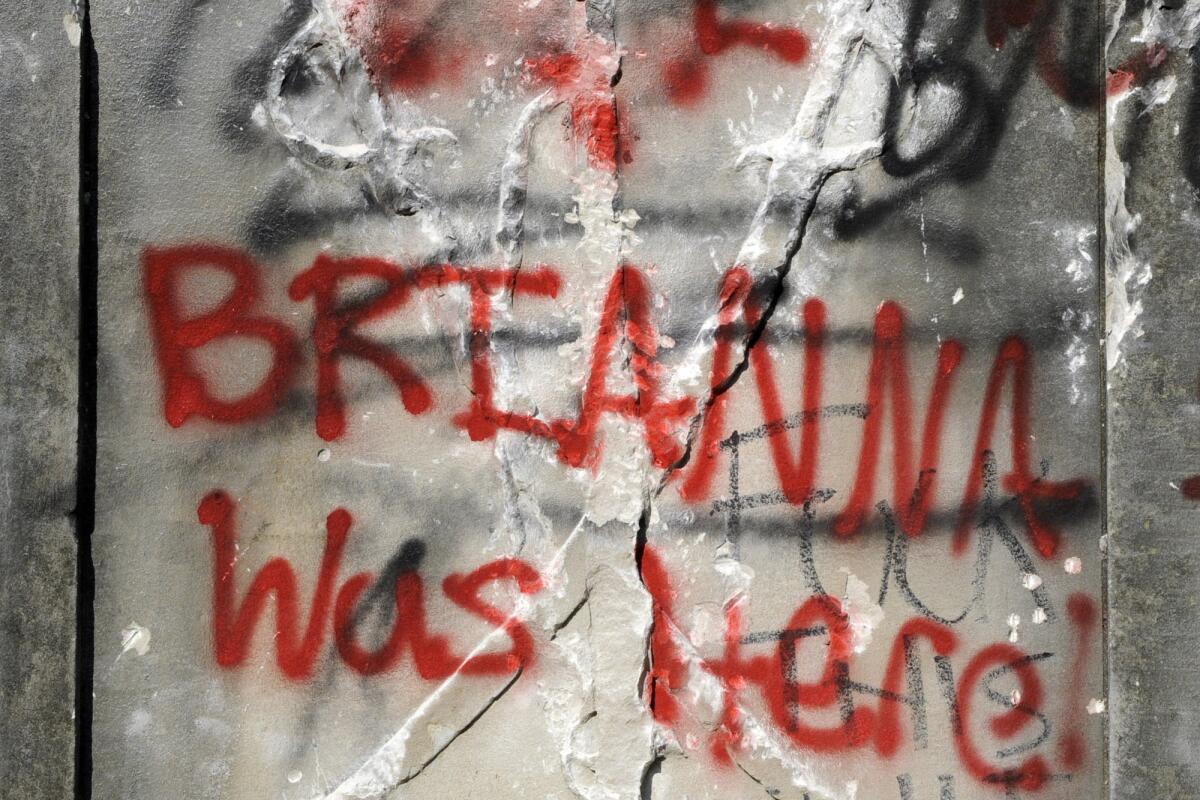
The removal of the Alexandria statue by the United Daughters of the Confederacy, the group that erected this and scores of other such sculptures and memorials, followed on the heels of another tear-down in Birmingham, Ala. Workers there on Monday morning began to dismantle a 52-foot-tall sandstone obelisk constructed in 1905.
The Confederate Soldiers and Sailors monument in downtown Birmingham’s Linn Park, named for Confederate naval Capt. Charles Linn, had been the target of demonstrators during protests Sunday night against police brutality.
In Richmond, 100 miles south of Alexandria, the mausoleum-like headquarters of the UDC was set on fire and tagged with abundant graffiti. Nearby Monument Avenue, which has a lineup of statues to Robert E. Lee, Jefferson Davis, J.E.B. Stuart and other secessionists who fought to maintain chattel slavery, was the scene of a police assault with tear gas against peaceful protesters. (Richmond Police Chief Will Smith later apologized for what he called an “unwarranted action.”) Protesters set out to systematically deface the street’s racist monuments.
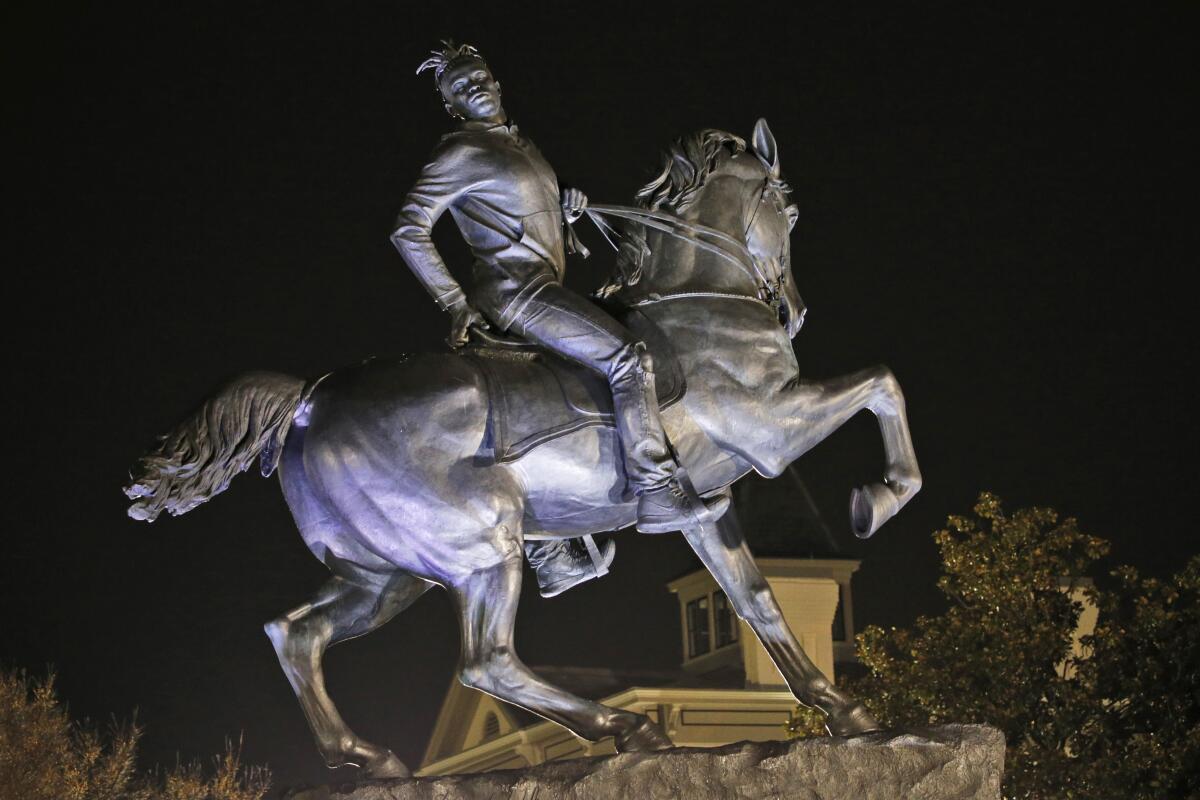
Just as methodically, they also took steps to protect a monumental Kehinde Wiley sculpture of a dreadlocked African American youth on horseback, erected in December in front of the Virginia Museum of Fine Arts, stationing protesters nearby. The museum, which stands next door to UDC headquarters, is temporarily closed due to the COVID-19 pandemic.
Shuttered inside the museum is “Working Together: Louis Draper and the Kamoinge Workshop,” a well-received survey exhibition of 15 early members of a black photographers’ collective, including Ming Smith and Roy DeCarava. Kamoinge launched in 1963 to cultivate self-representation among a largely voiceless minority, the camera becoming a visual microphone. The museum and the Wiley sculpture were unscathed while the righteous fury raged next door.
More than a dozen statues and symbols of the Confederacy have reportedly been damaged or defaced in recent days in at least six states, including Mississippi, Tennessee, Pennsylvania and North and South Carolina. In Florida, the Tampa chapter of the Sons of Confederate Veterans lowered its massive Stars and Bars flag, first raised above Interstate 4 in 2008 to honor Confederate President Davis’ 200th birthday.
A terse and searing example took place in Charlottesville, an hour northeast of Richmond.
The Lee equestrian statue there was one stimulus for the deadly 2017 “Unite the Right” rally of white supremacists and neo-Nazis, whom President Trump refused to condemn. Last weekend, the sculpture’s base was scrawled with paint. “The pandemic,” it said, an accusatory arrow pointing up at the bronze general astride his rearing horse.
Lee was the infecting virus, the sculpture its cruel disease.
Art is not supposed to be cruel, never mind a sickness. Confederate monuments are both. The only legitimate moral response to the growing iconoclasm toward them is: Good riddance.
And the only justifiable question that remains is: What took so long?
The answer is grim. Legislatures in most former Confederate states protect them.
Birmingham’s Democratic mayor, Randall Woodfin, had to defy a statewide law, enacted in wake of Charlottesville, to take the obelisk down. The 2017 Alabama Memorial Preservation Act prohibits local governments from removing, altering or renaming monuments more than 40 years old, like the Confederate Soldiers and Sailors monument, without state permission.
The law’s 40-year cutoff couldn’t be more revealing. It shields anything erected before the combative end of the modern civil rights era. Birmingham, a relatively liberal, black-majority Southern city, wants the racist monument gone; but Alabama, a conservative, white-majority Southern state, wants it kept.
Republican Gov. Kay Ivey described efforts to remove the state’s Confederate statues as “politically correct nonsense,” but she’s fooling no one. Woodfin engaged in a laudable act of peaceful civil disobedience. Confederate statues are the visible embodiment of systemic, institutionalized racism.
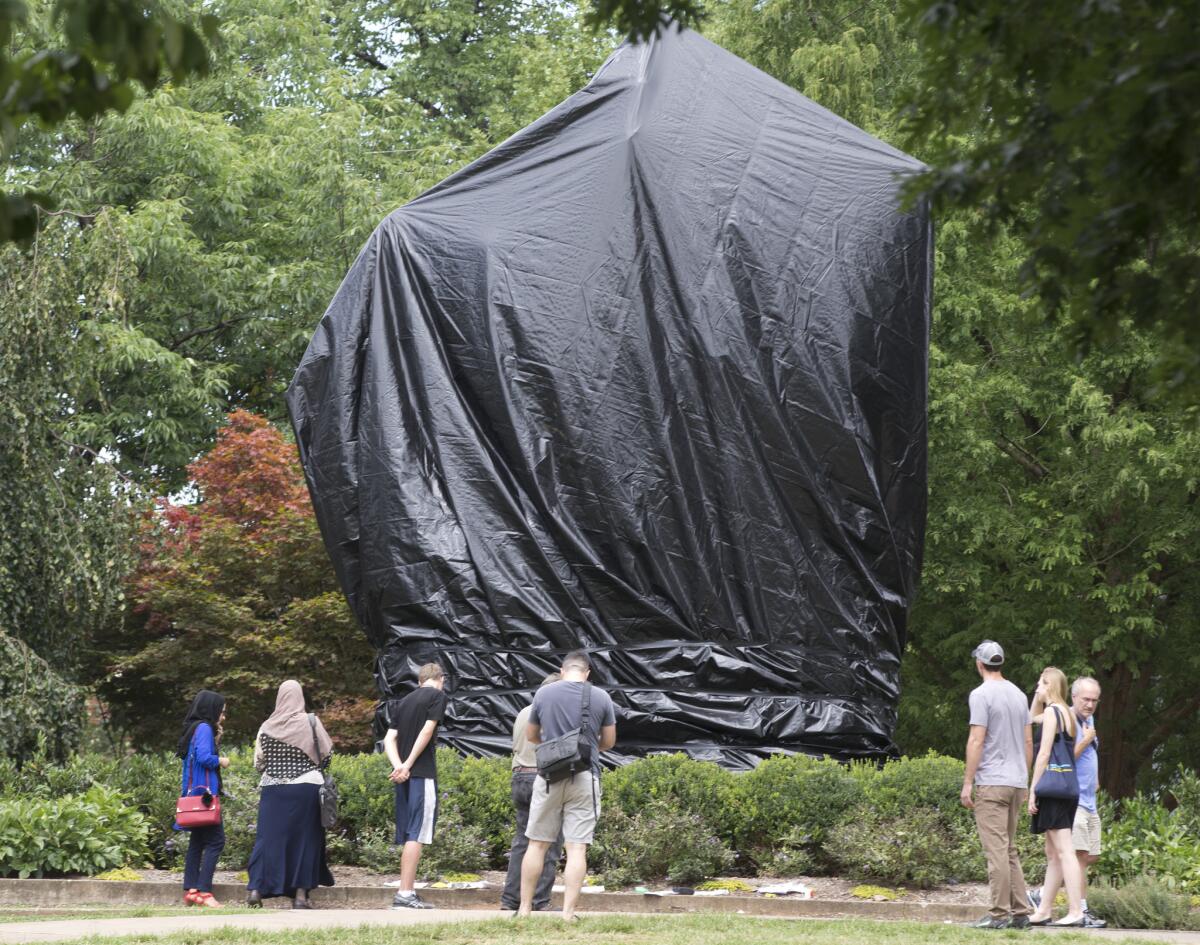
Georgia, Mississippi, North Carolina, South Carolina and Tennessee all have so-called monument protection laws on the books, cementing cold-blooded cruelty in place. A judge has twice blocked efforts to remove or cover the Charlottesville statue of Lee, based on a Virginia historic preservation statute and despite votes by the city council.
The heritage-versus-hate discussion is phony when the heritage is itself hate. Richmond Mayor Levar Stoney now appears to agree: He announced Wednesday the city’s intention to dismantle the Monument Avenue Confederate sculptures. Yet, even now, the website of the United Daughters of the Confederacy is a model of equivocation, filled with unctuous twaddle about ancestral bravery in war and not being judgmental now.
Floyd’s killing resonated loudly in Alexandria, where the “duty faithfully performed” had been treason in taking up arms against the United States to preserve the practice of white people owning other human beings. Confederate sculptures police social mores in spiritual and psychological terms, so the statue’s removal this week is progress — albeit of a costly kind.
Now, just 1,700 more to go.
More to Read
The biggest entertainment stories
Get our big stories about Hollywood, film, television, music, arts, culture and more right in your inbox as soon as they publish.
You may occasionally receive promotional content from the Los Angeles Times.

